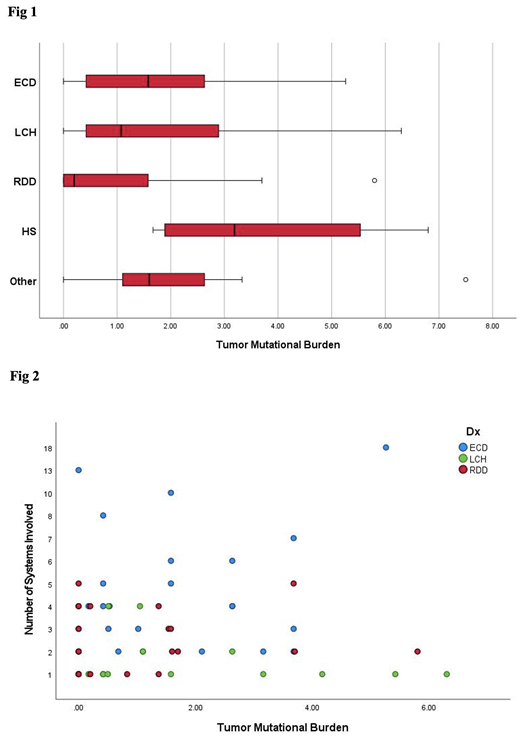Abstract

Background
Histiocytic disorders are rare hematologic neoplasms characterized by their high clinical heterogeneity. Evidence of constitutive activation of the mitogen-activated protein kinase (MAPK) pathway in a number of these disorders has led to the increasing use of BRAF- and MEK-inhibitors as a therapeutic strategy. Response to these therapies is not universal and additional effective treatment options are required. Immune checkpoint inhibitors have proven effective for a wide array of malignancies. Tumor mutational burden (TMB), the total number of somatic pathogenic variants per coding region in a tumor genome, is a clinical biomarker associated with response to immunotherapy. We have previously reported preliminary findings of low TMB in a small cohort of patients with histiocytic neoplasms (Goyal G et al. Blood 2019). In this study, our aim was to confirm the findings in a larger clinical cohort using next generation sequencing studies.
Methods
A retrospective review of adult patients consecutively seen at Mayo Clinic from 2017 to April 2021 and diagnosis of a histiocytic neoplasm was performed. Electronic records were queried for demographic and laboratory data of all patients who consented to undergo tumor-tissue next-generation sequencing with the Tempus-xT ® or xO ® assay (Chicago, IL), throughout the course of their evaluation. TMB was reported as the number of nonsynonymous mutations per coding area of a tumor genome. TMB across groups was compared via an independent-samples T-test or via analysis of variance and post hoc subgroup testing via Turkey's Test as required.
Results
Seventy-three patients were included in the study. Individual diagnoses included: Erdheim-Chester disease (ECD) in 31.5% (n=23), including 3 patients with overlap features of ECD and other histiocytoses; Rosai Dorfman disease (RDD) in 28.8% (n=21); Langerhans cell histiocytosis in 21.9% (n=16), histiocytic sarcoma (HS) in 5.5% (n=4), and other histiocytic neoplasms in 12.3% (n=10) including adult xanthogranuloma, xanthoma disseminatum, undifferentiated histiocytoses, and one case of Langerhans cell sarcoma.
Median tumor percentage on analyzed samples was 30% (range 10%-90%) and was ≤20% in 29 samples. TMB was <1.0 mutations per megabase (mpMb) in 42.5% (n=31) and >5.0 mpMb in only 6 cases. Median TMB was 1.58 (range 0 - 5.26) for ECD, 1.08 (range 0 - 6.3) for LCH, 0.2 (range 0 - 5.8) for RDD, 3.19 (range 1.67 - 6.8) for HS, and 1.6 (range 0 - 7.5) for other histiocytic neoplasms (Figure 1). No clear association between increasing TMB and number of systems with histiocytic infiltration was observed (Figure 2). A significant increase in TMB was observed among the 5 cases of sarcoma as compared to the rest of the cohort (p=0.014). When not considering sarcomas, no differences were observed in TMB between patients with ECD, LCH, RDD or other histiocytoses (F=0.775; p=0.512).
Conclusion
In this large cohort of histiocytic disorders, TMB was low compared to that historically seen in other neoplasms though this is likely influenced by tumor purity ≤20% in 29 cases. Only 6 tumors had TMB reports with mpMb above the threshold thought to be associated with an increased likelihood of response to PD-1/PDL1-targeted therapies (>5 mpMb). Our results suggest a low likelihood of response among histiocytic disorders using immune checkpoint inhibitors. Further exploration among malignant histiocytoses (HS and Langerhans cell sarcoma) is warranted given our findings of higher TMB compared with other histiocytic neoplasms.
Bennani: Kymera: Other: Advisory Board; Vividion: Other: Advisory Board; Kyowa Kirin: Other: Advisory Board; Daichii Sankyo Inc: Other: Advisory Board; Purdue Pharma: Other: Advisory Board; Verastem: Other: Advisory Board.
Author notes
 This icon denotes a clinically relevant abstract
This icon denotes a clinically relevant abstract


This feature is available to Subscribers Only
Sign In or Create an Account Close Modal